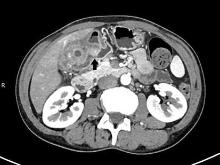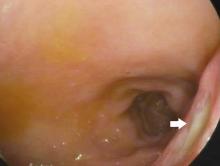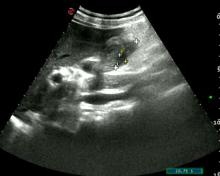| [1] |
Dong CHEN, Zhiyao LI, Haitao CHEN, Zhirui CHUAN, Yingxian ZHANG, Xin JIN, Shicong TANG, Xiaomao LUO.
Diagnostic values of three-dimensional transrectal ultrasound and MRI in diagnosis of T substages and circumferential resection margin of patients with middle and lower rectal cancer
[J]. Journal of Jilin University(Medicine Edition), 2021, 47(3): 753-760.
|
| [2] |
Dong CHEN,Zhiyao LI,Haitao CHEN,Zhirui CHUAN,Yingxian ZHANG,Xin JIN,Shicong TANG,Xiaomao LUO.
Diagnostic value of three-dimensional transrectal ultrasound in preoperative N-staging of middle and lower rectal cancer
[J]. Journal of Jilin University(Medicine Edition), 2021, 47(2): 497-504.
|
| [3] |
Dong CHEN,Haitao CHEN,Zhiyao LI,Fengming RANG,Xi ZHANG,Zhirui CHUAN,Shicong TANG,Xiaomao LUO.
Effects of three-dimensional transrectal ultrasound and MRI in evaluation of extramural vascular invasion degrees of middle and lower rectal cancer
[J]. Journal of Jilin University(Medicine Edition), 2021, 47(1): 203-209.
|
| [4] |
WANG Shaoheng, LIU Pengfei, GAO Teng, GUAN Lei.
Analgesic effects of different anesthesia methods on early pain of patients after hyperthermie intraperitoneal chemotherapy
[J]. Journal of Jilin University(Medicine Edition), 2020, 46(05): 1043-1049.
|
| [5] |
ZHANG Yiqun, JIANG Weibo, YUAN Sheng, YU Wei.
Analysis on follow-up results of postoperative function and recurrence of 23 patients with tenosynovial giant cell tumor in hand
[J]. Journal of Jilin University(Medicine Edition), 2020, 46(05): 1061-1064.
|
| [6] |
LIN Yuanqiang, JIANG Bo, LI Hequn, JIN Chunxiang, WANG Hui.
Application of hepatic transit time in portal vein pressure assessment in patients with portal hypertension and esophago gastric varices
[J]. Journal of Jilin University(Medicine Edition), 2019, 45(01): 170-174.
|
| [7] |
ZHENG Fang, OUYANG Zhengren, OUYANG Jinglin, ZHOU Shili, LUO Wen.
Analysis on correlations between ultrasound features and positive expressions of CerbB-2and Ki-67 in patients with breast cancer
[J]. Journal of Jilin University(Medicine Edition), 2018, 44(05): 1073-1077.
|
| [8] |
LIN Yu, LIU Meihan, SHI Weidong, SUN Zhixia, CHEN Enqi, ZHANG Xin, WANG Zhiyuan.
Application of ultrasonography in diagnosis and differential diagnosis of Takayasu arteritis
[J]. Journal of Jilin University Medicine Edition, 2017, 43(06): 1268-1271.
|
| [9] |
ZHAO Peng, FU Tong, ZHANG Xiuxiang, ZHAN Yue, GUAN Xin, SHI Aiping.
A case report of breast cancer complicated with thyroid cancer and dermatomyositis and literature review about relationships between three kinds of diseases
[J]. Journal of Jilin University Medicine Edition, 2017, 43(05): 1015-1018.
|
| [10] |
DU Siyun, GAI Baodong, QU Jia, YANG Dongyan.
Comparison of effects of ultrasound-guided implantation of radioative 125I particles in treatment of pancreatic cancer between percutaneous puncture and laparotomy
[J]. Journal of Jilin University Medicine Edition, 2017, 43(02): 381-385.
|
| [11] |
ZHENG Wen, CHEN Baofeng, LI Jie, ZHOU Yingying.
Application value of high frequence ultrasound in reinjection of facial autologous fat granule injection transplantation
[J]. Journal of Jilin University Medicine Edition, 2017, 43(01): 170-175.
|
| [12] |
YAN Haibo, MA Ning, CUI Chunli, LIU Tao, ZHAO Ling, JIANG Zhenyu.
Curative effect of febuxostat in treatment of gouty arthritis and its safety evaluation
[J]. Journal of Jilin University Medicine Edition, 2017, 43(01): 135-140.
|
| [13] |
LIN Yuanqiang, ZHANG Genmao, SUI Guoqing, GUO Li, LI Hequn, TANG Lidong, WANG Hui.
Comparison of application effects bwtween contrast-enhanced ultrasound and conventional ultrasound in liver neoplasm biopsy
[J]. Journal of Jilin University Medicine Edition, 2017, 43(01): 164-169.
|
| [14] |
GUO Li, YU Meiling, HAN Xiao, ZHANG Xiaoxia.
Ovarian nonspecific steroid cell tumor: A case report and literature review
[J]. Journal of Jilin University Medicine Edition, 2016, 42(05): 988-990.
|
| [15] |
CUI Yan, SHI Yongfeng, GUO Ziyuan, LIU Bin, WANG Jinpeng, ZHAO Lei, WANG Junnan, PIAO Jinhua.
Application of intravascular ultrasound in analysis on influencing factors of prognosis in patients with different coronary artery in-stent restenosis
[J]. Journal of Jilin University Medicine Edition, 2016, 42(04): 746-752.
|
 )
)











